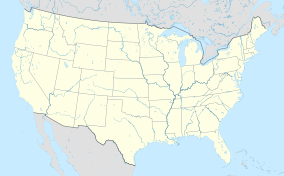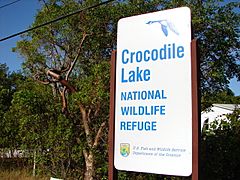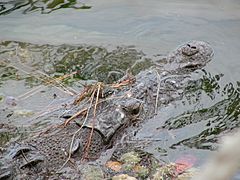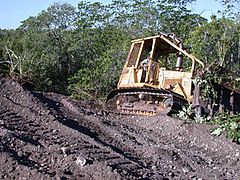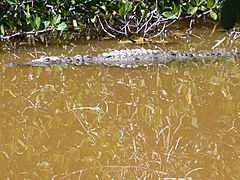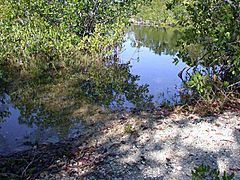Crocodile Lake National Wildlife Refuge facts for kids
Quick facts for kids Crocodile Lake National Wildlife Refuge |
|
|---|---|
|
IUCN Category V (Protected Landscape/Seascape)
|
|
| Location | Monroe County, Florida, United States |
| Nearest city | Key Largo, Florida |
| Area | 6,686 acres (27.1 km2) |
| Established | 1980 |
| Governing body | US Fish & Wildlife Service |
| Website | Crocodile Lake National Wildlife Refuge |
The Crocodile Lake National Wildlife Refuge is a special protected area in the United States. It's located in north Key Largo, about 40 kilometers (25 miles) south of Miami. This refuge was created in 1980 to protect important breeding and nesting areas for the American crocodile and other amazing wildlife.
The refuge covers 6,686 acres (about 27 square kilometers) of land and water. It includes 650 acres (2.6 square kilometers) of open water. Besides being one of only three places where American crocodiles breed, the refuge is also home to tropical hardwood hammock forests, mangrove forests, and salt marsh areas. It's managed as part of the National Key Deer Refuge, which is also in the Florida Keys.
Contents
History of the Refuge
The land that is now Crocodile Lake National Wildlife Refuge was once planned for houses and buildings. However, piles of dirt and sand from dredging (digging up the bay) became important nesting spots for American crocodiles. These crocodiles had almost disappeared because people hunted them for their skin. By 1975, there were only about 200 crocodiles left in the U.S.
The government stepped in to protect them. They listed the American crocodile as an endangered species. This meant it was in great danger of dying out. Because of these protection efforts, the crocodile population started to recover. In 2007, its status was changed from endangered to threatened. This means it's still protected, but not in as much danger. Hunting or capturing crocodiles is still against the law.
The refuge protects many other plants and animals besides the crocodile. The Key Largo Woodrat, Key Largo Cotton Mouse, Schaus Swallowtail butterfly, and Florida semaphore cactus are all endangered. The Stock Island Tree Snail and Eastern Indigo Snake are listed as threatened. These species are still struggling to survive in North Key Largo.
Over the years, a lot of their natural homes, like the tropical hardwood hammocks, were lost due to building and development. This caused the animal populations to shrink. To protect these rare species, the natural areas of the refuge are closed to the public. However, the refuge office offers brochures and has a butterfly garden that visitors can enjoy.
Amazing Animals
Key Largo Woodrat
The Key Largo woodrat is a type of rodent, like a mouse or a rat. It's not closely related to the common rats you might see in cities. This special woodrat lives mostly in hardwood hammocks. These forests are very important homes for this endangered animal.
The woodrats are having a tough time because their hammock homes are getting smaller. Also, pet cats that roam freely can hunt them. Researchers have found that woodrats like to build their nests under things that act like a "roof." This includes rock formations, fallen trees after hurricanes, and even overturned boats. These "roofs" protect them from predators and heavy rain.
Helping the Key Largo Woodrat
A special program was started to help the endangered woodrat population grow. Scientists would catch some woodrats and breed them in a safe, controlled environment. Then, their babies would be released back into the refuge.
Key Largo woodrats usually look for food at night, often in the treetops. They eat green leaves, flowers, buds, and fruit from trees. During the day, they hide in cracks in the island's limestone rock or under thick tree roots. Unlike common rats, woodrats don't usually live near people and don't eat garbage.
Sadly, the breeding program ended by 2010. Many of the young woodrats released into the wild were caught by predators, especially wild cats.
New Threats: Non-native Predators
Burmese Python
In 2007, something new and scary was found in the refuge: a Burmese python. Researchers were tracking a Key Largo woodrat with a radio collar when they found a 12-pound (5.4 kg) python. The radio signal was coming from inside the snake! It had eaten not just the collared woodrat, but another one too.
This was the first time a Burmese python was officially found living in the wild in the Florida Keys. Since then, more pythons have been found. These large snakes are a serious threat to the Key Largo woodrat and cotton mouse. They also threaten other rare mammals in the Florida Keys, like the Key Deer and Keys Marsh Rabbit.
Pythons and other large snakes hunt warm-blooded animals like mammals and birds. The animals in South Florida and the Keys have never faced such a large snake predator before. They might not be able to learn how to defend themselves quickly enough. Studies in Everglades National Park show that small mammal populations have dropped a lot where pythons are present.
Experts believe these pythons were once pets that either escaped or were released by owners who couldn't care for them anymore. Pythons are also good swimmers, so some might have swum from the Everglades to Key Largo.
Feral and Free-Roaming Cats
Wild cats and pet cats that roam freely are a big problem for the Key Largo woodrat and Key Largo cotton mouse. Cameras in the refuge have shown cats climbing on woodrat nests. Some cats have been found as far as 8 miles (13 km) from their owners' homes.
Refuge staff and volunteers catch these cats and take them to the local animal shelter. Owners whose cats keep trespassing in the refuge can even face fines. This is important to protect the endangered wildlife.
Amazing Plants
Tropical Hardwood Hammock
During the Cold War, a missile base was built on the land that is now the refuge. This base was built in an area that used to be a hardwood hammock forest. Many buildings and launch pads were constructed for military use.
By the year 2000, the refuge started a project to remove these old buildings and asphalt roads. The goal is to bring back more than 10 acres (40,000 square meters) of hardwood hammock habitat. These hammocks are very important because they provide homes for five federally endangered species, including the animals mentioned earlier.
Hardwood hammocks are made up mostly of special trees from the West Indies. In the mainland United States, these trees only grow in the very southern part of Florida. A lot of South Florida's hardwood hammock habitat was lost when cities and towns were built. The refuge is working hard to restore these valuable forests.
Keystone Pit Restoration Project
There's a large hole in the refuge called the "Keystone Pit," which is about 2.16 acres (8,740 square meters) wide. This pit was dug 30 to 40 years ago to get fossilized coral and limestone. These materials were used to build fireplaces and other structures.
The refuge manager, Steven Klett, wants to fill this hole to help restore the hammock habitat. Luckily, dirt and mud (called "muck") from widening U.S. 1 highway near Key Largo can be used. This "muck" contains natural materials that will help new plants grow. Scientists have checked the muck and say it doesn't have any harmful chemicals.
The main goal of filling the pit is to plant native trees and plants to create more hardwood hammock forest. This project helps both the Department of Transportation, which needs to get rid of the muck, and the refuge, which wants to restore its natural areas.
Gallery


